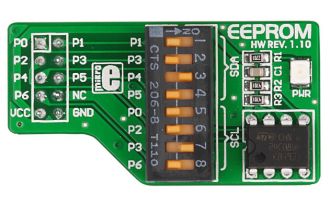
We strongly encourage users to use Package manager for sharing their code on Libstock website, because it boosts your efficiency and leaves the end user with no room for error. [more info]

Rating:
Author: MIKROE
Last Updated: 2016-02-18
Package Version: 1.0.0.0
Category: Storage
Downloaded: 17835 times
Followed by: 12 users
License: MIT license
Contains libraries for working with 24C02 EEPROM memory, low-voltage serial flash memory M25P80 and serial SRAM 23K640 device.
Do you want to subscribe in order to receive notifications regarding "External Memory" changes.
Do you want to unsubscribe in order to stop receiving notifications regarding "External Memory" changes.
Do you want to report abuse regarding "External Memory".
We present you with a collection of libraries for External Memories: Serial EEPROM, SerialRAM, SerialRAM PROTO, SerialFlash and SerialFlash PROTO.

The EEPROM board features a high reliable, high performance CMOS technology serial 8K EEPROM 24C08WP. It offers significant advantages in low-power and low-voltage applications. The 24C08WP EEPROM uses the I²C addressing protocol and 2-wire serial interface which includes a bidirectional serial data bus synchronized by the clock.
View full image